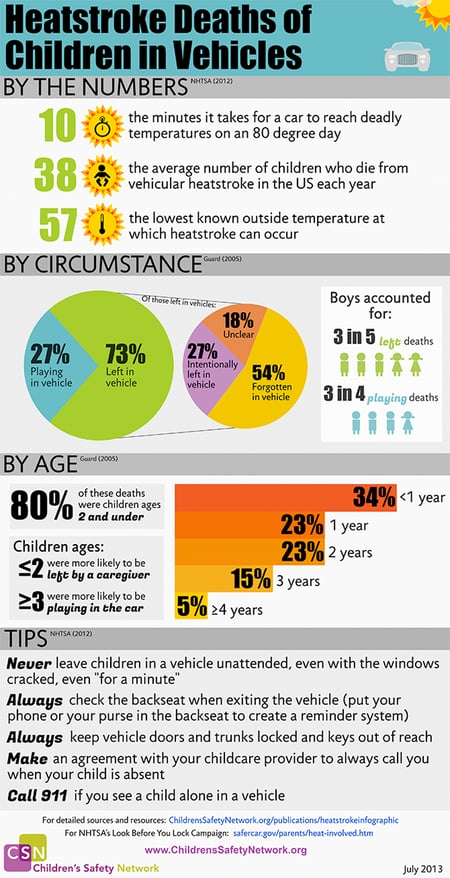With record-breaking high temperatures either happening now or coming your way soon, it’s a good time to think about heat safety. A particularly tragic instance of heat-related illness or death occurs when children (or pets) are left in vehicles on hot days.
Fortunately, the awareness campaigns of recent years appear to be paying off. According to a national survey sponsored by the Alliance of Automobile Manufacturers, “parent and caregiver awareness of the dangers [of children left in vehicles on hot days] continues to be high and the increased knowledge has led to positive changes in behavior.”
Mothers and fathers alike reported increased awareness of the risks of this child safety issue, and:
“Most importantly, the increased knowledge about child vehicle heat stroke deaths contributed to a majority now saying they would be less likely to leave their child alone in a vehicle, and nearly eight of ten reported they would take action - such as calling 911 -- if they see another child alone in a car.”
We can credit groups like the Children’s Safety Network for getting the word out about this issue. Check out this infographic from their website outlining the data about vehicle-related heat stroke incidents:
 |
What to do in case of heat stroke in children
Whether induced in a vehicle or otherwise, heat stroke is a true life-threatening medical emergency. It can occur due to overexertion in a hot humid environment or as the result of a breakdown in the body’s ability to shed heat. If body temperature rises significantly, it can quickly cause permanent damage to sensitive organs, including the brain and spinal cord.
In addition to the signs of heat exhaustion, a child with heat stroke will have an altered mental status. The skin can become red, very warm, or even hot, and be completely dry. Heavy sweating could be present, especially when exertion is the cause. The child may collapse and have a seizure.
Activate EMS immediately. Begin aggressive cooling with the resources that are available. Spray or pour water on the child and fan him. If available, cover the child with a wet sheet or towel. Apply ice packs to the child’s neck, groin, and armpits.
The best method, when possible, is to immerse the child in cool water up to the neck.
Provide continuous cooling until EMS arrives. With early recognition and immediate cooling a good chance for survival exists.
This summer and throughout the year, always check your vehicle to be sure all your little passengers have gotten out of the car with you before you lock up and leave it.
Ready to respond in an emergency? Now’s the perfect time to take that CPR, AED, and first aid class.








.png?width=600&name=HSI-CTA-EmergencyCareTraining%20(1).png)











Comments